Cool, exotic, affordable and renowned for superlative service, the land of smiles, which attracted a record 14 million tourists last year (2007), is of special interest to discerning Indian tourists. Ayutthaya, the earlier capital of the Thai kingdom founded by King U-Thong, was named after the sacred city of Ayodhya in India
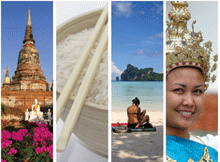 The south-east Asian kingdom of Thailand (pop. 63 million) is among the world’s most popular tourism destinations because of its unique environment, which combines an experience ranging from the culinary to the esoteric. Last year (2007) a record 14.46 million tourists including 500,000 from India visited Thailand. Cool, exotic and affordable, and matched by superlative service, this land of smiles beckons and welcomes visitors perennially.
The south-east Asian kingdom of Thailand (pop. 63 million) is among the world’s most popular tourism destinations because of its unique environment, which combines an experience ranging from the culinary to the esoteric. Last year (2007) a record 14.46 million tourists including 500,000 from India visited Thailand. Cool, exotic and affordable, and matched by superlative service, this land of smiles beckons and welcomes visitors perennially.
Bounded by Myanmar to the north, Laos in the east, Cambodia to the south-east and the Andaman Sea on its western seaboard, Thailand is a constitutional monarchy with His Majesty King Rama IX serving as the incumbent (ceremonial) ruler. Earlier known as Siam, the kingdom is a functional democracy spread over 513,000 sq. km in south-east Asia, with its southern peninsula jutting into the south China Sea.
Historical evidence indicates that humans have inhabited this nation since the Paleolithic period (about 10,000 years ago). Excavations in the village of Ban Chiang in north-east Thailand have uncovered architectural evidence of a Bronze Age dating back to 3600 B.C. Subsequently, from 800-1200 A.D, the Khmer people of contemporary Cambodia occupied the central and eastern regions of Thailand, leaving behind their architecturally distinct stone temples of Phimai and Phanom Rung. In 1238, the Sukhothai Kingdom wrested independence from the Khmer rulers. In 1279, King Ramkhanhaeng united the regions and ascended the throne, bequeathing the legacy of the Thai alphabet. After his death the Sukothai Kingdom fell into decline, and thereafter was born the Ayutthaya Kingdom (1351-1767), which dominated southern and central Thailand until the 18th century.
Contemporary Thailand is of special interest to the more selective Indian tourists, because the country has an ancient linkage with India. Ayutthaya, the earlier capital of the Thai Kingdom, was founded by King U-Thong (later known as King Ramathibodi I), who named it after the sacred city of Ayodhya in India. He imported Theravada Buddhism from India and decreed it as the official religion. Ramathibodi I also adopted the Dharmashastra — a legal code of Hindu origin — and blended it with traditional Thai customs to establish a legal system which was in force until the late 19th century. However in 1767, a Burmese expeditionary force destroyed Ayutthaya, leaving it in ruins, which is now a designated UNESCO World Heritage Site.
European traders arrived in Thailand in the 16th century, led by the Portuguese. Portuguese traders were followed by the French, Dutch and the British, who through their trademark artifices transformed it into a British protectorate for over 300 years (1600-1900s). Nevertheless as in India, British influence in the kingdom was not an unmixed blessing and resulted in the construction of a national railway, waterways and roads, schools and the country’s first post office and printing press. Subsequently, following the freedom movement in India, and Asia during the 1940s, particularly after the French were ousted from the Indo-China peninsula in 1954, the kingdom became an American sphere of influence and during the Cold War (1950-1989), went through decades of political transgression characterised by coups d’etat, before establishing a light manufactures exports industry, and transforming into a democracy in the 1980s.
Thailand is divided into four natural regions of which northern Thailand’s mountainous forests are renowned for their spectacular waterfalls, caves and wildlife. The southern coastal region is ideal for aquatic pleasures with an abundance of natural wilderness, and is the heart of Thailand’s rice bowl area irrigated by the Chao Phraya River. The north-east is characterised by undu-lating hills and is perhaps the most undiscovered region of the country, despite constituting almost a third of its total area.
The religion practiced by more than 95 percent of Thais is Theravada Buddhism. The official spoken and written language is Thai; however English is widely understood and spoken across the country.
Thailand has a warm, tropical climate affected by a seasonal monsoon, and the best time to visit is between the months of November and early July before the start of the monsoon. Thai Airways and other numerous international airlines offer daily/weekly flights from major cities of India.
Central and Western Thailand
Central Thailand is the country’s political and cultural heart, because of the myriad charms of Bangkok (pop.5.7 million), particularly its raucous nightlife. Starting as a small trading post at the mouth of the Chao Phraya River, it is now one of the most attractive cities (its traffic snarls excepted) of Asia with everything from cuisine to craft and culture, to commend it.
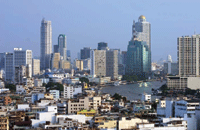 Coterminously Bangkok also has hundreds of Buddhist temples, notably the Wat Arun (Temple of Dawn) and Wat Phra Kaew (Temple of the Emerald Buddha). It was originally built on a network of canals, many of which are still used for transport of goods and people. The Chao Phraya River, which pulsates with local commerce and music, has garlands of lights around the quaint wooden houses flanking it, to say nothing of the misty orchid farms that also line the shores.
Coterminously Bangkok also has hundreds of Buddhist temples, notably the Wat Arun (Temple of Dawn) and Wat Phra Kaew (Temple of the Emerald Buddha). It was originally built on a network of canals, many of which are still used for transport of goods and people. The Chao Phraya River, which pulsates with local commerce and music, has garlands of lights around the quaint wooden houses flanking it, to say nothing of the misty orchid farms that also line the shores.
Not to be missed in Bangkok is the culinary art of Thailand, fast catching up and catering to international palates. Tantalising local delicacies are offered in innumerable restaurants in the city, and are an absolute must try. Of course, the ultimate indulgence which no visitor can resist is the pampering of skilled masseurs at the luxurious spas and chic parlours dotting Bangkok. Perfect for re-energising mind, body and soul.
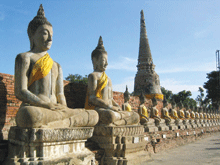 Located an hour’s drive south-west of Bangkok, the colourful and chaotic Floating Market is a unique oriental sight. About 100 km north of Bangkok is Ayutthaya, where you can loiter around the ruins of this timeless city.
Located an hour’s drive south-west of Bangkok, the colourful and chaotic Floating Market is a unique oriental sight. About 100 km north of Bangkok is Ayutthaya, where you can loiter around the ruins of this timeless city.
Kanchanaburi, sited 130 km west of Bangkok, is where nature enthusiasts can enjoy amazing waterfalls, mountains, caves and numerous hot springs. The historic Bridge on the River Kwai evokes awe and nostalgia even today. Hua Hin, a beach resort, combines the attractions of a modern holiday destination with the old world charm of an active fishing port. Restaurants overlooking the ocean offer superb seafood and classic Thai cuisine.
Accommodation. High-end: Four Seasons Hotel, from Rs.10,500 per night; Grand Hyatt, from Rs.9,000. Deluxe and Budget: Intercontinental Bangkok, from Rs.8,000; Imperial Queen’s Park Hotel, from Rs.3,500; Bangkok Garden Resort, from Rs.2,600.
Eastern Thailand
Eastern thailand comprises 400 km of coastline from Chonburi and Pattaya to Rayong, Chantaburi and Trat. Well known and the closest beach to the capital city in Chonburi province, is Pattaya. Beach bums can spend idyllic evenings sunlounging on its talcum sands, or indulge in thrilling water sports like windsurfing, sailing, snorkeling and scuba diving.
.gif) If you’re looking for quiet, balmy evenings, then North Pattaya is a perfect hangout unlike Central and South Pattaya, which are bustling perennially. Jomtien Beach has an excellent selection of accommodation and restaurants. A trip offshore to Koh Lan (Coral Island) is just heavenly. From snorkeling to viewing pristine coral gardens through glass-bottom boats, the island has much to offer. Apart from beaches, you can visit the Elephant Village, or loiter in the misty Noong Nooch Tropical Garden. Pattaya also hosts a Ripley’s Believe It or Not Museum that houses a vast collection of the bizarre and unbelievable.
If you’re looking for quiet, balmy evenings, then North Pattaya is a perfect hangout unlike Central and South Pattaya, which are bustling perennially. Jomtien Beach has an excellent selection of accommodation and restaurants. A trip offshore to Koh Lan (Coral Island) is just heavenly. From snorkeling to viewing pristine coral gardens through glass-bottom boats, the island has much to offer. Apart from beaches, you can visit the Elephant Village, or loiter in the misty Noong Nooch Tropical Garden. Pattaya also hosts a Ripley’s Believe It or Not Museum that houses a vast collection of the bizarre and unbelievable.
Largely unknown but beautiful, is Thailand’s second largest island — Koh Chang in Trat province, located in the heart of a national marine park. Some of the best snorkeling is around the island reefs, where you can expect to see stingrays and moray eels. Koh Chang’s islands also happen to be nature at its most tropically lovely, and for exploring the rainforested islands, there are several hiking trails and jungle treks.
Accommodation. High-end: Dusit Thani Pattaya, from Rs.8,500 per night; Le Vimarn Cottage & Spa, from Rs.8,000. Deluxe and Budget: Garden Cliff Resort & Spa, from Rs.4,500; Ao Phrao Resort, from Rs.4,200; Koh Chang Marina & Resort, from Rs.2,000.
North-Eastern Thailand
In the north-eastern region of Thailand referred to as Isaan, there is refreshingly little action, perfect for relaxation. The gateway to the whole area is through Nakorn Ratchasima, called Korat where a distinct Laotian and Khmer influence is reflected in the local dialect and cuisine. For foodies, it’s worth trying out ethnic cuisine such as som tam (a spicy papaya salad) and gai yang (roasted spiced chicken).
North-east Thailand is also well known for its Matmee silk items, wicker- ware, earthenware and a variety of edible goods. The areas around Roi Et and Korat are famed for production of fine silks, and some great bargains can be struck by discerning visitors.
Accommodation. Deluxe and Budget: Ban Chiang Hotel, from Rs.9,000 per night; The Greenery Resort, from Rs.2,500.
Northern Thailand
Comprising many hill tribes and spectacular scenic beauty, Northern Thailand is a world away from the seductions of Bangkok. Chiang Mai (pop.1.74 lakh) the most culturally significant city of the north, sits amidst a stunning mountain range. It’s dotted with over 300 temples offering an ethereal, spiritual and historical environment. Pay a visit to Wat Phrathat Doi Suthep, an ancient temple that dates back to 1383 and Wat Chiang Man, the country’s oldest temple that houses two venerated Buddha figures, in marble and crystal.
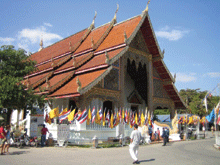 Chiang Mai is modern and friendly, a visitor’s delight with lots to recommend it. When in the city, acquaint yourself with local history and culture at the National Museum and Tribal Museum. The tick-list of outdoor activities includes rock climbing, mountain biking, bamboo rafting, hill-tribe trekking and a visit to the elephant park. Famous for its handicrafts, shopping in Chiang Mai is just as adventurous; a visit to the night bazaar is mandatory. Eating out in Chiang Mai gives you the chance to sample ethnic Thai cuisine at its very best.
Chiang Mai is modern and friendly, a visitor’s delight with lots to recommend it. When in the city, acquaint yourself with local history and culture at the National Museum and Tribal Museum. The tick-list of outdoor activities includes rock climbing, mountain biking, bamboo rafting, hill-tribe trekking and a visit to the elephant park. Famous for its handicrafts, shopping in Chiang Mai is just as adventurous; a visit to the night bazaar is mandatory. Eating out in Chiang Mai gives you the chance to sample ethnic Thai cuisine at its very best.
Other prominent northern towns include Lamphun, where picturesque horse-drawn carriages still ply the streets. Mae Hong Son town boasts several Burmese style temples and exceptional scenic beauty, perfect for nature lovers. Sited at an elevation of 580 metres above sea level, with Myanmar and Laos at its borders, is Chiang Rai. Visit the Wat Phra That Doi Thong, an ancient hilltop pagoda overlooking the Mae Kok River, or try something different like being cast adrift at sunset on a local raft, to view the surrounding beauty.
Accommodation. High-end: Le Meridien, from Rs.7,500 per night. Deluxe and Budget: Horizon Village & Resort, from Rs.2,000; Pai Spa Resort, from Rs.2,300; Teak Garden Spa Resort & Hotel, from Rs.1,800.
Southern Thailand
Located in the southern province at the mouth of the Krabi River is the town of Krabi with a good selection of sightseeing, and water sports. Ao Nang Beach has a number of small islands off the bay from where one can take boat trips, or hire canoes either daily or hourly. Snorkeling, scuba diving and fishing trips are organised from most beaches. Rock climbing is perfect for a bout of physical exertion and you could also explore the limestone cliffs in the area.
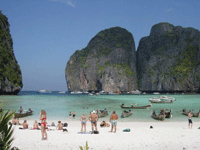 Around 176 km from Krabi is the island of Phuket (pop.3.13 lakh) which hosts trendy resorts, ever-humming beaches and delectable cuisine. Mostly mountainous, Phuket is exceptionally dramatic from every angle. Several coral islands such as the Similan Islands and Phi Phi are globally renowned for deep sea diving. Surrounded by sheer cliffs, Phi Phi Islands are draped in shallow coral reefs, teeming with exotic fish.
Around 176 km from Krabi is the island of Phuket (pop.3.13 lakh) which hosts trendy resorts, ever-humming beaches and delectable cuisine. Mostly mountainous, Phuket is exceptionally dramatic from every angle. Several coral islands such as the Similan Islands and Phi Phi are globally renowned for deep sea diving. Surrounded by sheer cliffs, Phi Phi Islands are draped in shallow coral reefs, teeming with exotic fish.
While several segments of Phuket’s coastline were devastated by the tsunami of December 2004, the damage has been repaired and the island offers eco-adventure tours in its dense forests, and excursions centred around Phang Nga Bay.
Accommodation. High-end: Hilton Phuket Arcadia Resort & Spa, from Rs.7,000 per night; Sawasdee Village, from Rs.5,500. Deluxe and Budget: Secret Cliff Resort, from Rs.3,500; Millennium Resort, from Rs.2,800.
South-East Islands
Adventurous travellers in search of unspoiled natural beauty and diving thrills can explore the islands of Koh Samui and Koh Tao.
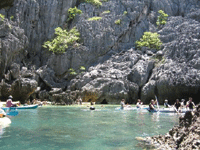 Thailand’s third largest island, Koh Samui draws a million visitors annually, with its reputation for excellent spas, alternative therapy centres and exhilarating golf. The hippest beachside resort on the island is Chaweng, hub of a vibrant night life.
Thailand’s third largest island, Koh Samui draws a million visitors annually, with its reputation for excellent spas, alternative therapy centres and exhilarating golf. The hippest beachside resort on the island is Chaweng, hub of a vibrant night life.
Located in the Gulf of Siam, a little north off Koh Samui, is the island of Koh Phangan. Famed for its full-moon parties, the island is the perfect hideaway for backpackers and party animals. Had Kuat (Bottle beach) to the north is incredibly inviting with inexpensive accommodation and a vast selection of restaurants.
Accommodation. High-end: Melati Beach Resort & Spa, from Rs.9,000 per night; Villa Lawana, from Rs.9,500. Deluxe and Budget: Silavadee Pool Spa Resort, from Rs.5,000; Chaweng Garden Beach Resort, from Rs.3,000; Ananda Yoga Resort, from Rs.1,200.
Fiona Fernandes